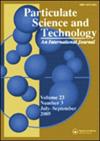Investigating the fundamental properties of iron ore granules when combined with varying amounts of liquid and different powder binders
IF 1.5
4区 工程技术
Q3 ENGINEERING, CHEMICAL
引用次数: 0
Abstract
AbstractThe study focused on how different moisture levels (5%–11%) and powder binders affected the bulk and strength characteristics of three iron ore blends. Increasing liquid content initially decreased and then increased the bulk density of all blends, and the shear strength of Blend-A and Blend-B increased up to 9% liquid content and then decreased at 11%, while Blend-C had a higher shear strength. In Blend-A, the cohesion varies between 0.64 and 5.49 kPa, while the internal frictional angle varies between 39.05° to 46.75°. For Blend-B, the cohesion ranges from 1.03 to 4.05 kPa, and the internal frictional angle ranges from 45.00° to 47.90°. Furthermore, Blend-C has cohesion ranging from 2.71 to 3.97 kPa and internal frictional angle ranging from 45.00° to 50.07°. Blend-A was considered a base blend using three powders, and the impact of adding these powders was assessed using Blend-A. HL maintained the cohesion at 4.50 kPa, and the internal frictional angle of Blend-A was significantly increased by 49.62° in the presence of HL. QL powder maintained cohesion values (1.47 kPa) and high internal frictional angle values (51°). Similarly, calcite powder sustained cohesion values (2.49 kPa) and high internal frictional angle values (51.96°).Keywords: Iron ore mixturepowder binderbulk densitymoistureshear strengthtensile strengthcohesioninternal friction angleparticle size Disclosure statementNo potential conflict of interest was reported by the author(s).Additional informationFundingThis work was supported by National Natural Science Foundation of China (51906212).研究铁矿颗粒与不同数量的液体和不同的粉末粘合剂结合时的基本性质
摘要研究了不同含水率(5% ~ 11%)和粉末粘结剂对三种铁矿石混料的体积和强度特性的影响。随着掺量的增加,各共混物的容重先降低后升高,且掺量为9%时,共混物a和共混物b的抗剪强度先升高后降低,掺量为11%时,共混物c的抗剪强度更高。Blend-A的黏聚力在0.64 ~ 5.49 kPa之间,内摩擦角在39.05°~ 46.75°之间。Blend-B的黏聚力为1.03 ~ 4.05 kPa,内摩擦角为45.00°~ 47.90°。此外,Blend-C的黏聚力为2.71 ~ 3.97 kPa,内摩擦角为45.00°~ 50.07°。blend - a被认为是使用三种粉末的基础混合物,使用blend - a评估添加这些粉末的影响。HL维持了4.50 kPa的黏聚力,并且在HL的存在下,Blend-A的内摩擦角显著增加了49.62°。QL粉末保持了1.47 kPa的粘聚力值和51°的高内摩擦角值。同样,方解石粉具有2.49 kPa的黏结力值和51.96°的高内摩擦角值。关键词:铁矿石混合物粉末粘结剂堆积密度水分剪切强度拉伸强度黏结内摩擦角粒度披露声明作者未报告潜在利益冲突。项目资助:国家自然科学基金项目(51906212)。
本文章由计算机程序翻译,如有差异,请以英文原文为准。
求助全文
约1分钟内获得全文
求助全文
来源期刊

Particulate Science and Technology
工程技术-工程:化工
CiteScore
4.40
自引率
4.00%
发文量
86
审稿时长
12 months
期刊介绍:
Particulate Science and Technology, an interdisciplinary journal, publishes papers on both fundamental and applied science and technology related to particles and particle systems in size scales from nanometers to millimeters. The journal''s primary focus is to report emerging technologies and advances in different fields of engineering, energy, biomaterials, and pharmaceutical science involving particles, and to bring institutional researchers closer to professionals in industries.
Particulate Science and Technology invites articles reporting original contributions and review papers, in particular critical reviews, that are relevant and timely to the emerging and growing fields of particle and powder technology.
 求助内容:
求助内容: 应助结果提醒方式:
应助结果提醒方式:


